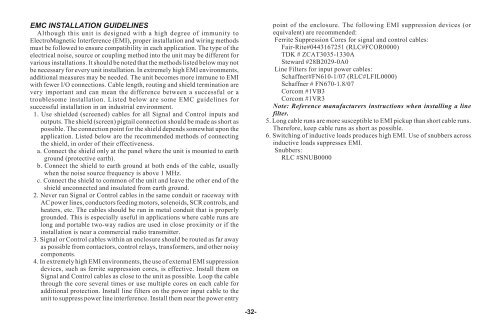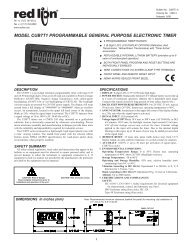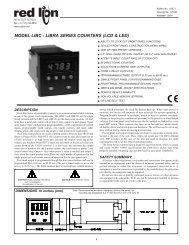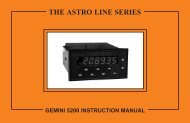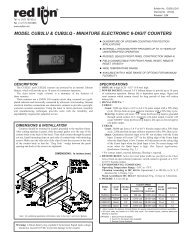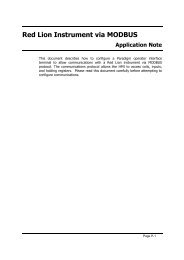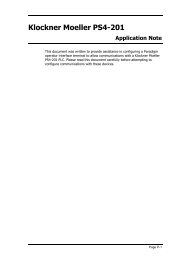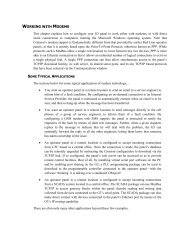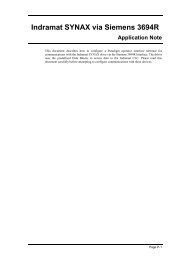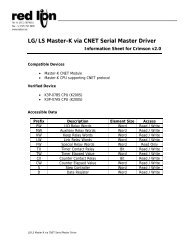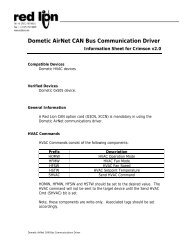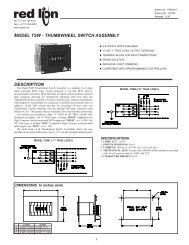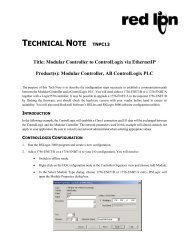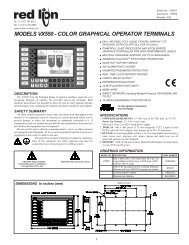MDC Manual 1109KB - Red Lion Controls
MDC Manual 1109KB - Red Lion Controls
MDC Manual 1109KB - Red Lion Controls
You also want an ePaper? Increase the reach of your titles
YUMPU automatically turns print PDFs into web optimized ePapers that Google loves.
EMC INSTALLATION GUIDELINES<br />
Although this unit is designed with a high degree of immunity to<br />
ElectroMagnetic Interference (EMI), proper installation and wiring methods<br />
must be followed to ensure compatibility in each application. The type of the<br />
electrical noise, source or coupling method into the unit may be different for<br />
various installations. It should be noted that the methods listed below may not<br />
be necessary for every unit installation. In extremely high EMI environments,<br />
additional measures may be needed. The unit becomes more immune to EMI<br />
with fewer I/O connections. Cable length, routing and shield termination are<br />
very important and can mean the difference between a successful or a<br />
troublesome installation. Listed below are some EMC guidelines for<br />
successful installation in an industrial environment.<br />
1. Use shielded (screened) cables for all Signal and Control inputs and<br />
outputs. The shield (screen) pigtail connection should be made as short as<br />
possible. The connection point for the shield depends somewhat upon the<br />
application. Listed below are the recommended methods of connecting<br />
the shield, in order of their effectiveness.<br />
a. Connect the shield only at the panel where the unit is mounted to earth<br />
ground (protective earth).<br />
b. Connect the shield to earth ground at both ends of the cable, usually<br />
when the noise source frequency is above 1 MHz.<br />
c. Connect the shield to common of the unit and leave the other end of the<br />
shield unconnected and insulated from earth ground.<br />
2. Never run Signal or Control cables in the same conduit or raceway with<br />
AC power lines, conductors feeding motors, solenoids, SCR controls, and<br />
heaters, etc. The cables should be run in metal conduit that is properly<br />
grounded. This is especially useful in applications where cable runs are<br />
long and portable two-way radios are used in close proximity or if the<br />
installation is near a commercial radio transmitter.<br />
3. Signal or Control cables within an enclosure should be routed as far away<br />
as possible from contactors, control relays, transformers, and other noisy<br />
components.<br />
4. In extremely high EMI environments, the use of external EMI suppression<br />
devices, such as ferrite suppression cores, is effective. Install them on<br />
Signal and Control cables as close to the unit as possible. Loop the cable<br />
through the core several times or use multiple cores on each cable for<br />
additional protection. Install line filters on the power input cable to the<br />
unit to suppress power line interference. Install them near the power entry<br />
-32-<br />
point of the enclosure. The following EMI suppression devices (or<br />
equivalent) are recommended:<br />
Ferrite Suppression Cores for signal and control cables:<br />
Fair-Rite#0443167251 (RLC#FCOR0000)<br />
TDK # ZCAT3035-1330A<br />
Steward #28B2029-0A0<br />
Line Filters for input power cables:<br />
Schaffner#FN610-1/07 (RLC#LFIL0000)<br />
Schaffner # FN670-1.8/07<br />
Corcom #1VB3<br />
Corcom #1VR3<br />
Note: Reference manufacturers instructions when installing a line<br />
filter.<br />
5. Long cable runs are more susceptible to EMI pickup than short cable runs.<br />
Therefore, keep cable runs as short as possible.<br />
6. Switching of inductive loads produces high EMI. Use of snubbers across<br />
inductive loads suppresses EMI.<br />
Snubbers:<br />
RLC #SNUB0000


